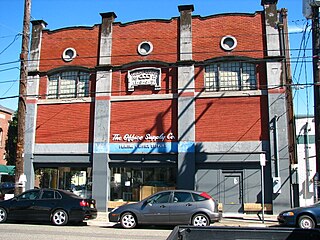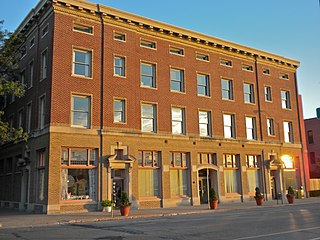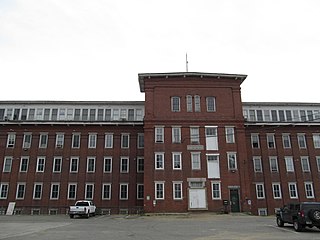
The National Register of Historic Places (NRHP) is the United States federal government's official list of sites, buildings, structures, districts, and objects deemed worthy of preservation for their historical significance or "great artistic value".

The U.S. National Register of Historic Places (NRHP) classifies its listings by various types of properties. Listed properties generally fall into one of five categories, though there are special considerations for other types of properties which do not fit into these five broad categories or fit into more specialized subcategories. The five general categories for NRHP properties are: building, district, object, site, and structure.

The Lakeville Historic District in Salisbury, Connecticut is a historic district that was listed on the National Register of Historic Places in 1996. It is also the name of a local historic district that was established in 1970. The local historic district is entirely included within the National Register-listed district.

Tifton Commercial Historic District, in Tifton in Tift County, Georgia, is a historic district that was listed on the National Register of Historic Places (NRHP) in 1986 and expanded in 1994. The original listing was portions of 10 blocks including buildings from the 1890s to the late 1930s, most built of brick.

There are nine historic districts in Meridian, Mississippi. Each of these districts is listed on the National Register of Historic Places. One district, Meridian Downtown Historic District, is a combination of two older districts, Meridian Urban Center Historic District and Union Station Historic District. Many architectural styles are present in the districts, most from the late 19th century and early 20th century, including Queen Anne, Colonial Revival, Italianate, Art Deco, Late Victorian, and Bungalow.

The Crescent Warehouse Historic District is a 10.5-acre (4.2 ha) historic district in Downtown Davenport, Iowa, United States. The district is a collection of multi-story brick structures that formerly housed warehouses and factories. Most of the buildings have been converted into loft apartments. The district was listed on the National Register of Historic Places in 2003.

The East Portland Grand Avenue Historic District, located in southeast Portland, Oregon, is listed on the National Register of Historic Places. The district includes approximately 20 city blocks on or near Southeast Grand Avenue on the east side of the Willamette River, roughly bounded on the south by SE Main Street, north by SE Ankeny Street, west by SE Martin Luther King Jr. Boulevard, and east by SE Seventh Avenue. Most structures in the district are commercial buildings rising two to three stories. Immediately to the west of the historic district is Portland's east side industrial area, and to the east are industrial and residential areas.

Morgantown Wharf and Warehouse Historic District is a national historic district located at Morgantown, Monongalia County, West Virginia.

The Northwestern Hotel is a historic building located in the East Village of Des Moines, Iowa, United States. It was listed on the National Register of Historic Places in 1984. In 2017 it was included as a contributing property in the East Des Moines Industrial Historic District.

The Fifth Street Bluff Historic District is a nationally recognized historic district located in Ottumwa, Iowa, United States. It was listed on the National Register of Historic Places in 1998. At the time of its nomination it contained 67 resources, which included 40 contributing buildings, three contributing structures, and 24 non-contributing buildings.
Darlington Industrial Historic District is a national historic district located at Darlington, Darlington County, South Carolina. The district encompasses 12 contributing buildings and 1 contributing structure in an industrial section of Darlington. They were built between about 1890 and 1925. All of these buildings are located along the rights-of-way of the South Carolina Western Railway and the Charleston, Sumter and Northern Railroad since the industries each of these buildings served employed the services of the railroad. Among the prominent resources in the district are the Charleston, Sumter and Northern Railway Freight Station (1891), the Darlington Roller Mill (1899), Thomas and Howard Tobacco Warehouse ; and Price's Tobacco Warehouse, and a cotton warehouse.

The Salmon Falls Mill Historic District encompasses a historic mill complex on Front Street in Rollinsford, New Hampshire. The complex includes four major structures and seven smaller ones, on about 14 acres (5.7 ha) of land along the Salmon Falls River. They were built between about 1840 and the mid-1860s, and have an unusual architectural unity, for additions made to the buildings were done with attention to matching design elements from the existing structures. The Number 2 Mill, built in 1848, was an early location where a turbine was used instead of a waterwheel to provide power to the mill machinery. The district was listed on the National Register of Historic Places in 1980.

The Marshalltown Downtown Historic District is a historic district located in Marshalltown, Iowa, United States. It was listed on the National Register of Historic Places in 2002. At the time of its nomination it contained 96 resources, which included 79 contributing buildings, one contributing site, and 16 non-contributing buildings. The historic district covers most of the city's central business district. All of it is within the original town of Marshalltown, which was laid out and recorded on August 15, 1853, as the village of Marshall. Confusion with a town with the same name in Henry County led this village to be renamed Marshalltown in 1862. It was incorporated the following year.

The Bonaparte Historic Riverfront District is a nationally recognized historic district located in Bonaparte, Iowa, United States. It was listed on the National Register of Historic Places in 1989. At the time of its nomination it contained 38 resources, which included 24 contributing buildings, one contributing structure, 11 non-contributing buildings, and two non-contributing structures. Three mill-related buildings near the Des Moines River are associated with the Meek's family who had a central role in the town's development from its founding through the turn of the 20th-century. They include the woolen mill (1863), the flour mill (1878), which is individually listed on the National Register, and the pants factory (1892). Eighteen commercial buildings are of brick construction. Of those, eight are two-story structures, and ten are single-story structures. The remaining three buildings are wood frame commercial buildings. The single historic structure is the stone lock in the city park, which is also individually listed on the National Register.

The Battery Street Historic District encompasses one of the oldest developed areas of Burlington, Vermont. With a history dating to 1790, this area, south of downtown Burlington and initially bounded roughly by Main, St. Paul, and Maple Streets, and Lake Champlain, this area includes a mix of residential, commercial, and industrial uses, with architecture spanning from its early period to the 20th century, including one of the city's oldest houses. The district was listed on the National Register of Historic Places in 1977, and has twice been enlarged, extending west to South Union Street.

The Mills Tower Historic District is a nationally recognized historic district located in Iowa Falls, Iowa, United States. It was listed on the National Register of Historic Places in 1990. At the time of its nomination the district consisted of six resources, including two contributing buildings, and four non-contributing buildings. All of the buildings are associated with the Illinois Central Railroad (IC). The Dubuque & Sioux City Railroad, an affiliate of the IC, laid the first rail track to Iowa Falls in 1866. The following year the Iowa Falls & Sioux City Railroad, another IC affiliate, continued construction of the line to the west, and it reached Sioux City by 1870. The Burlington, Cedar Rapids and Northern Railway (BCR&N) by way of its affiliate the Cedar Rapids, Iowa Falls & North Western, entered Iowa Falls in 1880. Two years later it was expanded to the north and intersected with the IC main line, which required a controlled crossing. Little is known about this first crossing and what it contained.

East Park is a recreational park located in Mason City, Iowa, United States. It was listed as a historic district on the National Register of Historic Places in 2014. At the time of its nomination it contained 21 resources, which included three contributing buildings, one contributing site, five structures, seven non-contributing buildings, and five non-contributing structures. It contains 57.6 acres (23.3 ha) of land along the Winnebago River. The park features picnic areas, a 9-hole disc golf course, three tennis courts, volleyball court, basketball courts, fishing, a sledding hill, playgrounds including the Prairie Playground, a 2.08-mile (3.35 km) hard surface trail system, a band shell and a gazebo.

The Davenport Motor Row and Industrial Historic District or Pete Stopulos Row is a nationally recognized historic district located on the eastern edge of downtown Davenport, Iowa, United States. It was listed on the National Register of Historic Places in 2019.

The Palmerton Historic District is a national historic district located in Palmerton, Carbon County, Pennsylvania. Bordered roughly by Tomb Street, Avenue A, 8th Street, and Harvard Avenue, it encompasses 1,262 contributing buildings, seven contributing structures, and four contributing sites, as well as 475 noncontributing buildings and 13 noncontributing sites where previously demolished resources had been located. Usage functions range from commercial and industrial to institutional to residential in nature. This district was added to the National Register of Historic Places on January 19, 2018 in recognition of its significance in community planning and development.

The Davenport Downtown Commercial Historic District is a nationally recognized historic district located in the central business district of Davenport, Iowa, United States. It was listed on the National Register of Historic Places in 2020. At the time of its nomination it consisted of 43 resources, which included 33 contributing buildings, one contributing structure, and nine non-contributing buildings. In addition, the district also contains 33 buildings that are individually listed on the National Register. This historic district is bordered by four other districts: the Crescent Warehouse Historic District and the Davenport Motor Row and Industrial Historic District on the east, the Hamburg Historic District to the northwest, and the West Third Street Historic District on the west.






















